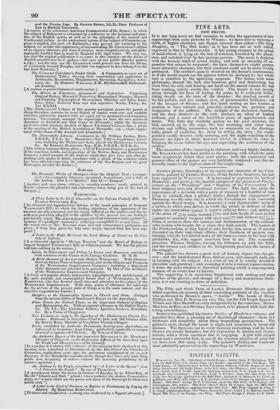FINE ARTS.
NEW PRINTS.
IT is not long since we had occasion to notice the appearance of two engravings from early pictures by Thrum:: we have now to welcome a third, of higher character and deeper interest than either—The 04 Daughter,. or " The Sick Lady," as it has been not so well callea, engraved in line by ENGELHEART. A fair young creature in the prime of maidenhood is lying on the bed of sickness, attended by the physi. clan, and watched over by her anxious parents. The scene is depicted with the homely truth of actual reality, and with an intensity of ex-
pression that cannot be surpassed : the faces themselves might possess. more attractive character, but their emotions could not be more vividly portrayed. The mother's gaze is rivetted on the doctor's countenance, as if she" would ,search out his opinion before he declared it ; her whole soul is absorbed by the agonizing suspense. The father, with more philosophy, though his look also betokens grief and foreboding, has risen from his seat, and leaning one hand on the sacred volume he had been reading, calmly awaits the verdict. The doctor is ' not merely going through the form of feeling the pulse, he is evidently delibe- rating deeply on the state of the disorder : the pinched mouth of his fair patient, and her sunken eyes, of preternatural brilliancy, tell of the ravages of disease ; and her hand resting on her bosom—a position at once natural and graceful—indicates the patience and resignation of the sufferer. The twilight of the darkened chamber, and the deep shadows on the wall, produce an effect of hushed stillness, and a sense of the breathless pause of apprehension and doubt. The little dog wistfully gazing on his poor mistress, the bird covered up in the cage, the lute unstrung, and other more obvious and trifling accessories, such as ornaments on the dressing- table, phials of medicine, &c. assist in telling the story : the extin- guished candle denotes early morniug, and the night-watching of the parents : no object in short, however triVial, is without its value in bringing the scene before the eye, and expressing the sentiment of the subject.
The execution of the engraving is elaborate and very highly finished. Mr. ENGELIIEART has done justice to the painting, with which the print bears comparison better than most plates : both the expression and general effect of the picture are very fifithfully rendered; and this de- servedly ranks M the highest class of fine engravings.


























 Previous page
Previous page